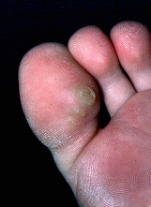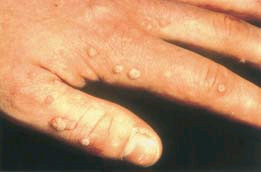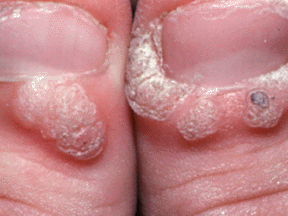Human Papillomavirus 1,2, and 4
Plantar and Common Warts
 3* 3* |
 1* 1* |
 2* 2* |
Incubation
Several months
Epidemiology
HPV 1, 2, and 4 make up 90% of warts and they include common and plantar warts. It is found frequently in older children and young adults where the peak incidence is at the age of 12 through 16. There seems to be a recent increase in infection rate in Europe and the United States compared to Asia, Australia, and Africa. There is however a 10 % prevalence in school children.
Symptomatology and Outcome
HPV enters the skin through small abrasions, particularly if the skin is moist and warm upper epidermis rather than in the proliferating basal-cell layer. These HPV strains affect usually the hands and feet. Trauma may account for the distribution of warts on the hands and feet. Nail-biting in children and shaving in men, as well as ill-fitting shoes in adults, are all relevant factors. Some 20 per cent of warts disappear within 6 months and 65 per cent in 2 years. They are all benign for the most part. Common warts are scaly, rough, spiny papules or nodules. They occur singly or can be in multiples. The knuckles and nail-folds are particularly favored, as are the knees and, more rarely, the penile shaft. A plantar wart begins as a small ‘sago-grain’ papule. As it get bigger, paring the surface with a scalpel distinguishes the wart from the surrounding horny ring of normal epidermis and reveals the small capillaries in the tips of the elongated papillae. Plantar (plantar surface of the foot) and palmar warts may be thick, endophytic, and hyperkeratonic. Most warts occur over pressure points. Clusters of small warts make up a mosaic.
Prevention and Management
There is really no real prevention tactic for these kinds of HPV strains.
Lesions may present themselves within several months and disappear within
the next 2 years. However, some warts may persist indefinitely. Most treatments
are aimed at destroying the lesioned tissue, but also damaging permanently
the surrounding tissue area.
Treatment may include surgery, cryosurgery (may include the use of liquid
nitrogen), electrocauterization, laser therapy, cytotoxic agents like topical
treatment like podophyllin, urea, trichloroacetic acid, salicylic acid, fluorouracil
(Efudex) and interferon alpha.
Overall, 12 weeks is the usual time required to cure warts irrespective of
the treatment used.
Picture References:
1) Oxford Book of Medicine. 2) http://cybermed.ucsd.edu/derm2/Case1/wartfingers.html
3)http://www.telemedicine.org/warts/fig4b.jpg